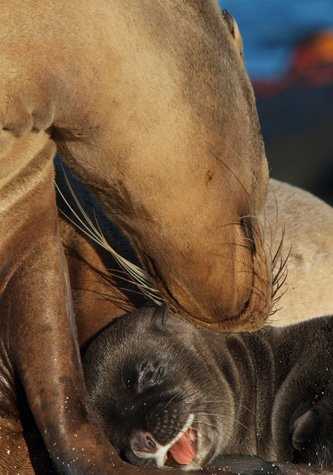We navigated north back into the northern hemisphere during the night. A strong current pushed us along too quickly, so for a short time the First Officer turned our engines off and we floated, rocking on the currents. By 0600 we were navigating along again in position off the island of Isabela and when we came on deck soon after sunrise we found the ocean calm and smooth. South of the ship we could see the tallest of the six volcanoes that make up this large island: Wolf. I explained to our guests that a new species of land iguana has recently be named – a pink iguana – which lives only on the upper slopes of Volcano Wolf!
We searched the horizon for whales and dolphins but found instead only a couple of fur seals, and a half dozen different species of sea birds. Most exciting was seeing at least 30 dark-rumped petrels. They are endemic sea birds that nest in the highlands in burrows in the ground. For many years they were endangered because feral mammals and rats ate their eggs and chicks. The national park personnel has been protecting the nesting areas and intensively poisoning and trapping the predators so this rare bird is slowly increasing in numbers again in the islands. We were delighted to see several dozen of these attractive birds swooping and diving around the ship this morning. I remember just 30 years ago when these sea birds were still exceedingly rare. Thanks to the hard work of park wardens they have been saved from certain extinction.
We crossed the equator line with a blow of the ship’s horn and many of us had our pictures taken on the bow. We are once again in the southern hemisphere and headed to our anchorage off of Punta Vicente Roca where we lowered the four Zodiacs and went out for a cruise along the coast. We had lovely cool weather and good sights, with a frenzy of feeding juvenile cormorants that beat up their parents as they begged for food, and sightings of mola sunfish and penguins among the highlights. Back on the ship we changed quickly into our snorkeling gear and went out in three pangas. The water was clear and warm and the number and variety of fish, reptiles, mammals, and birds we saw while snorkeling was amazing!
There were dozens of sea turtles, some feeding, some swimming, and others sleeping on the sandy bottom. Penguins zipped past us and a cormorant dove to search for fish and octopus among the rocks. A graceful sea lion swirled around us and at least two dozen species of fish – some in large schools and others individually swimming in the azure waters – enchanted us. We were reluctant to leave at noon but ready for a hearty lunch when it was announced soon after we had returned to the ship.
By afternoon the sun was out, the tide was high and a cool breeze blew from the south. We disembarked for a two hour walk at Punta Espinoza on Fernandina Island. This is a magical place and for both the guides and the guests this will no doubt be one of the most memorable walks of the week. There were marine iguanas everywhere; the males starting to bob their heads aggressively and defend territories. We saw many shore birds: whimbrels, oyster catchers, ruddy turnstones and semi-palmated plovers. Galapagos hawks were flying about and there were sea turtles in the shallows. A sweet newborn sea lion pup – with a part of its umbilical cord still intact – snuggled against his Mom; they were obviously still getting to know one another.
As the sun set and the western sky turned a brilliant orange, we made our way back to the landing beach, through the super high tide, and into the waiting Zodiacs. What a full and exciting day we have had in the islas encantadas!



.jpg?width=106&height=85&mode=crop&scale=both&quality=50)



